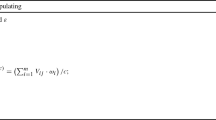Abstract
The operation of the mobile interactive autonomous learning system injects advanced management technology and scientific and reasonable management system for the effective management and arrangement of the school's teaching, enables students to conduct autonomous learning in their spare time, makes full use of students' fragmented time, and improves students' learning enthusiasm and efficiency. Based on the neural network algorithm, this paper constructs an English network learning interactive evaluation model, studies the influence of the flattening layer in the convolutional neural network structure on the structural complexity, and then proposes spatial pyramid weighted average pooling to optimize the traditional flattened layer. Moreover, this paper evaluates RSPP from three aspects: space complexity, training time-consuming, and accuracy. In addition, this paper designs two types of integrated convolutional neural networks, namely Bagging integration and snapshot integration. Finally, this paper evaluates the performance of the model through experiments and counts the experimental results. The research results show that the model constructed in this paper has a certain effect.




















Similar content being viewed by others
References
Qian Q, Jin R, Yi J et al (2015) Efficient distance metric learning by adaptive sampling and mini-batch stochastic gradient descent (SGD). Mach Learn 99(3):353–372
Dong H, Gong S, Liu C et al (2017) Large margin relative distance learning for person re-identification. IET Comput Vis 11(6):455–462
Delgaty L (2015) Twelve tips for academic role and institutional change in distance learning. Med Teacher 37(1):41–46
Stefanovic M, Tadic D, Nestic S et al (2015) An assessment of distance learning laboratory objectives for control engineering education. Comput Appl Eng Educ 23(2):191–202
Remesh BP (2015) Developing open and distance learning programme in labour and development: results of a needs assessment study. J Nat Hist 196(29):265–291
Wu P, Low SP, Liu JY et al (2015) Critical success factors in distance learning construction programs at Central Queensland University: students’ perspective. J Prof Issues Eng Educ Pract 141(1):05014003
Ye HJ, Zhan DC, Jiang Y (2019) Fast generalization rates for distance metric learning: improved theoretical analysis for smooth strongly convex distance metric learning. Mach Learn 108(2):267–295
Luo Y, Wen Y, Liu T et al (2019) Transferring knowledge fragments for learning distance metric from a heterogeneous domain. IEEE Trans Pattern Anal Mach Intell 41(4):1013–1026
Hsu CC, Kung CH, Jheng JJ et al (2019) Unsupervised distance learning for extended self-organizing map and visualization of mixed-type data. Intell Data Anal 23(4):799–823
Linhares RN, Alcântara CMG, Gonçalves EÁ et al (2017) Teaching evaluation by teachers from Brazil and Portugal: a comparative analysis. Am J Educ Res 5(5):546–551
Huang N (2017) Analysis and design of university teaching evaluation system based on JSP platform. Int J Educ Manag Eng 7(3):43–50
Liu S, Chen P (2015) Research on fuzzy comprehensive evaluation in practice teaching assessment of computer majors. Int J Modern Educ Comput Sci 7(11):12–19
Zhou L, Li H, Sun K (2016) Teaching performance evaluation by means of a hierarchical multifactorial evaluation model based on type-2 fuzzy sets. Appl Intell 46(1):1–11
Porozovs J, Liepniece L, Voita D (2015) Evaluation of the teaching methods used in secondary school biology lessons. Nephron Clin Pract 7(1):60–66
Oliveros MA, García A, Valdez B (2015) Evaluation of a teaching sequence regarding science, technology and society values in higher education. Creative Educ 6(16):1768–1775
Cerón MS, del Sagrario Corte Cruz FM (2015) The evaluation of teaching: some consequences for Latin America. Rev Mex Investig Educ 20(67):1233–1253
Li A, Li K, Ge Z (2015) Application of data mining in the colleges’ in-class teaching quality evaluation system. J Comput 10(3):166–175
Brkovic M, Chiles P (2016) ‘Spector—the sustainability inspector’: participatory teaching, learning and evaluation game for architects, architecture students and pupils. Facta Univ 14(1):1–20
Reisenwitz TH (2015) Student evaluation of teaching: an investigation of nonresponse bias in an online context. J Mark Educ 38(4):139–144
Jiang Y, Wang Y (2016) Evaluation of teaching quality of public physical education in colleges based on the fuzzy evaluation theory. J Comput Theor Nanosci 13(12):9848–9851
Royal K (2016) A guide for making valid interpretations of student evaluation of teaching (SET) results. J Vet Med Educ 44(2):1–7
Eckler U, Greisberger A, Höhne F et al (2017) Blended learning versus traditional teaching–learning–setting: evaluation of cognitive and affective learning outcomes for the inter-professional field of occupational medicine and prevention. Nephron Clin Pract 4(2):109–121
Garofalo F, Mota-Moya P, Munday A et al (2017) Total extraperitoneal hernia repair: residency teaching program and outcome evaluation. World J Surg 41(1):1–6
Zhao H (2015) College physics teaching model design and evaluation research of students’ seriousness. Open Cybern Syst J 9(1):2017–2020
Tran ND (2015) Reconceptualisation of approaches to teaching evaluation in higher education. Issues Educ Res 25(1):50–61
Acknowledgements
This research was supported by the scholarship awarded to Xiyao Hong from China Scholarship Council (CSC, 201808440641) for her academic visiting at the University of Manchester (Manchester, UK) during the academic year 2018–2019.
Author information
Authors and Affiliations
Corresponding author
Ethics declarations
Conflict of interest
The authors declare that they have no competing interests.
Additional information
Publisher's Note
Springer Nature remains neutral with regard to jurisdictional claims in published maps and institutional affiliations.
Rights and permissions
About this article
Cite this article
Hong, X. Interactivity of English online learning based on neural network. Neural Comput & Applic 34, 3349–3364 (2022). https://doi.org/10.1007/s00521-021-05701-8
Received:
Accepted:
Published:
Issue Date:
DOI: https://doi.org/10.1007/s00521-021-05701-8




